NISSAN FRONTIER 2022 Owner´s Manual
Manufacturer: NISSAN, Model Year: 2022, Model line: FRONTIER, Model: NISSAN FRONTIER 2022Pages: 556, PDF Size: 6.11 MB
Page 71 of 556
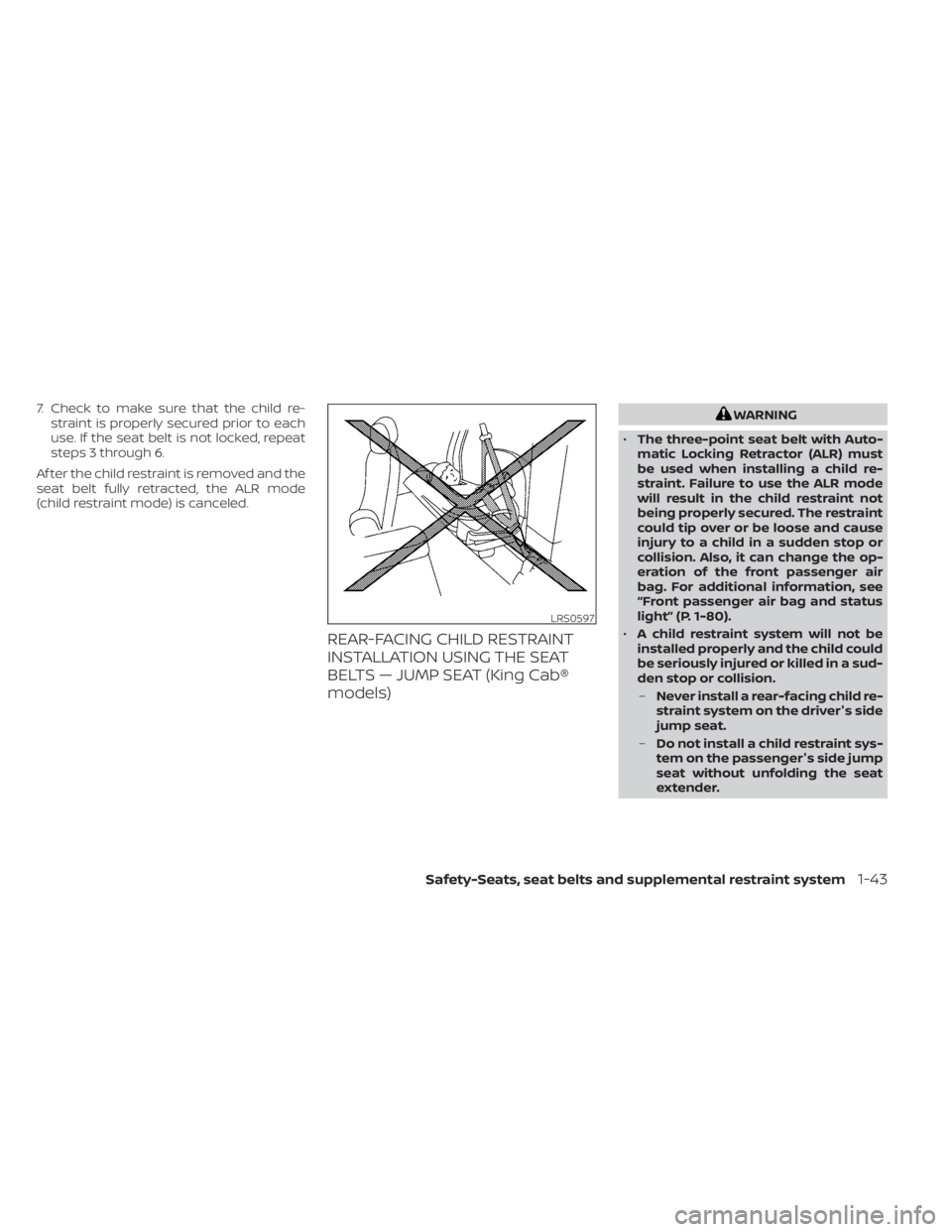
7. Check to make sure that the child re-straint is properly secured prior to each
use. If the seat belt is not locked, repeat
steps 3 through 6.
Af ter the child restraint is removed and the
seat belt fully retracted, the ALR mode
(child restraint mode) is canceled.
REAR-FACING CHILD RESTRAINT
INSTALLATION USING THE SEAT
BELTS — JUMP SEAT (King Cab®
models)
WARNING
• The three-point seat belt with Auto-
matic Locking Retractor (ALR) must
be used when installing a child re-
straint. Failure to use the ALR mode
will result in the child restraint not
being properly secured. The restraint
could tip over or be loose and cause
injury to a child in a sudden stop or
collision. Also, it can change the op-
eration of the front passenger air
bag. For additional information, see
“Front passenger air bag and status
light” (P. 1-80).
• A child restraint system will not be
installed properly and the child could
be seriously injured or killed in a sud-
den stop or collision.
– Never install a rear-facing child re-
straint system on the driver's side
jump seat.
– Do not install a child restraint sys-
tem on the passenger's side jump
seat without unfolding the seat
extender.
LRS0597
Safety-Seats, seat belts and supplemental restraint system1-43
Page 72 of 556
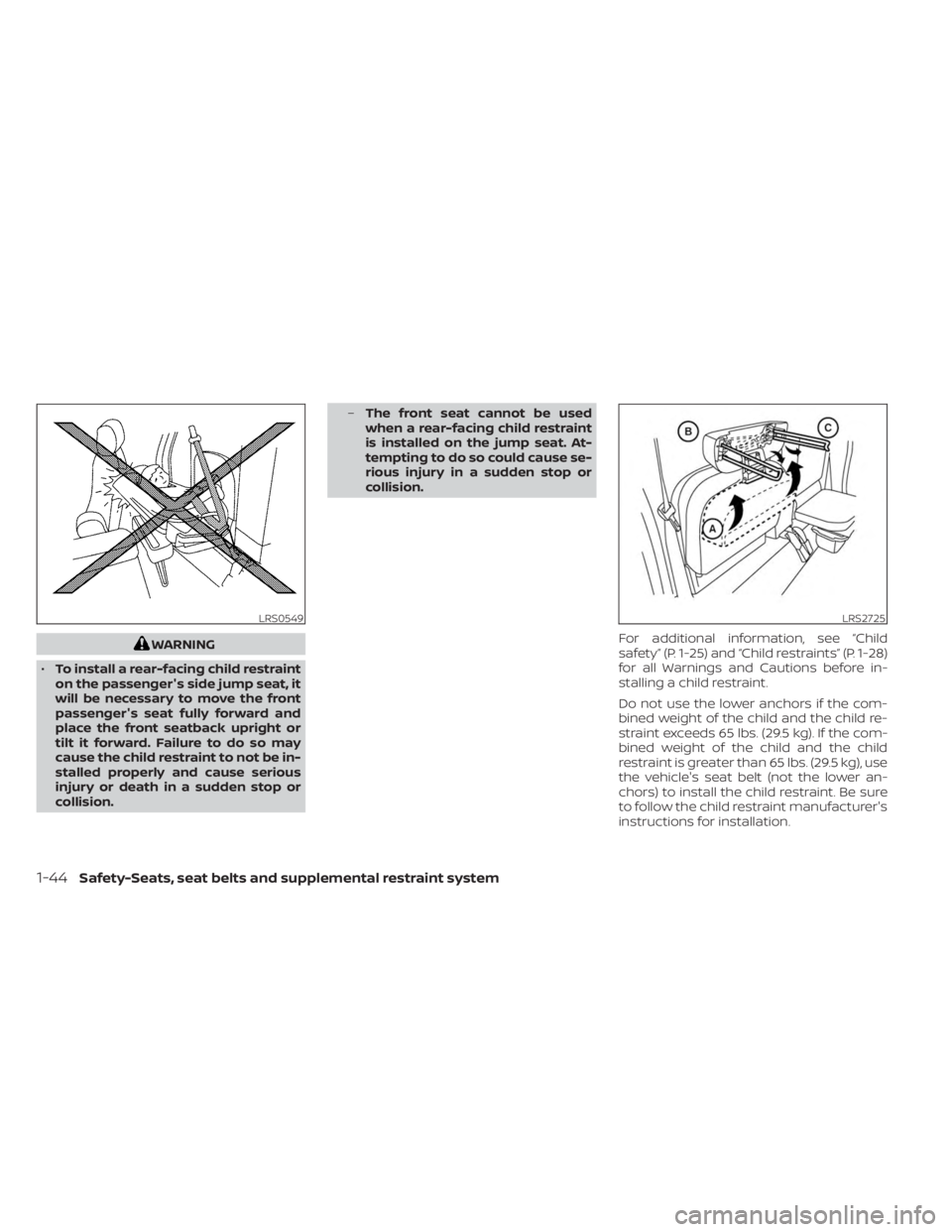
WARNING
• To install a rear-facing child restraint
on the passenger's side jump seat, it
will be necessary to move the front
passenger's seat fully forward and
place the front seatback upright or
tilt it forward. Failure to do so may
cause the child restraint to not be in-
stalled properly and cause serious
injury or death in a sudden stop or
collision. –
The front seat cannot be used
when a rear-facing child restraint
is installed on the jump seat. At-
tempting to do so could cause se-
rious injury in a sudden stop or
collision.
For additional information, see “Child
safety” (P. 1-25) and “Child restraints” (P. 1-28)
for all Warnings and Cautions before in-
stalling a child restraint.
Do not use the lower anchors if the com-
bined weight of the child and the child re-
straint exceeds 65 lbs. (29.5 kg). If the com-
bined weight of the child and the child
restraint is greater than 65 lbs. (29.5 kg), use
the vehicle's seat belt (not the lower an-
chors) to install the child restraint. Be sure
to follow the child restraint manufacturer's
instructions for installation.
LRS0549LRS2725
1-44Safety-Seats, seat belts and supplemental restraint system
Page 73 of 556
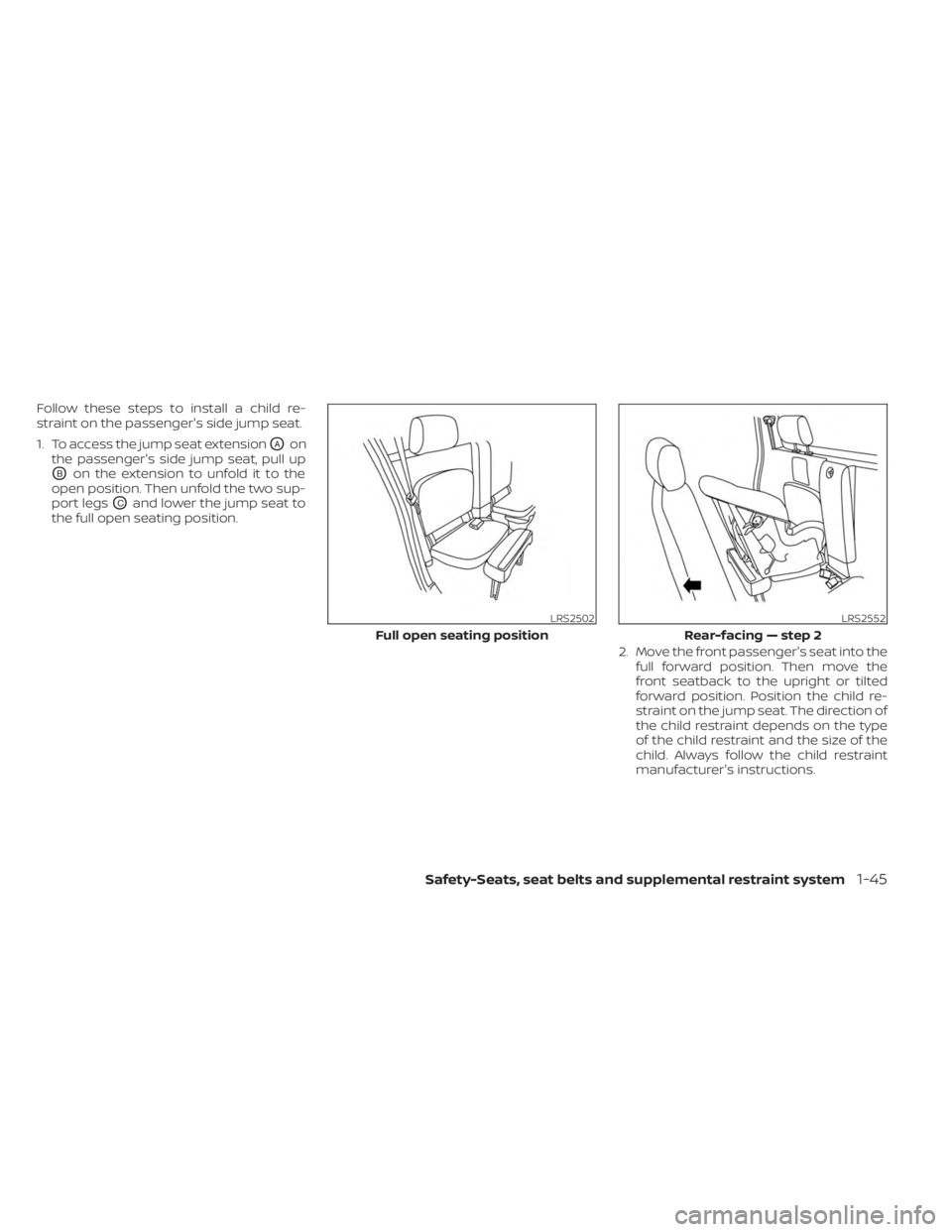
Follow these steps to install a child re-
straint on the passenger's side jump seat.
1. To access the jump seat extension
OAon
the passenger's side jump seat, pull up
OBon the extension to unfold it to the
open position. Then unfold the two sup-
port legs
OCand lower the jump seat to
the full open seating position.
2. Move the front passenger's seat into thefull forward position. Then move the
front seatback to the upright or tilted
forward position. Position the child re-
straint on the jump seat. The direction of
the child restraint depends on the type
of the child restraint and the size of the
child. Always follow the child restraint
manufacturer's instructions.
LRS2502
Full open seating position
LRS2552
Rear-facing — step 2
Safety-Seats, seat belts and supplemental restraint system1-45
Page 74 of 556
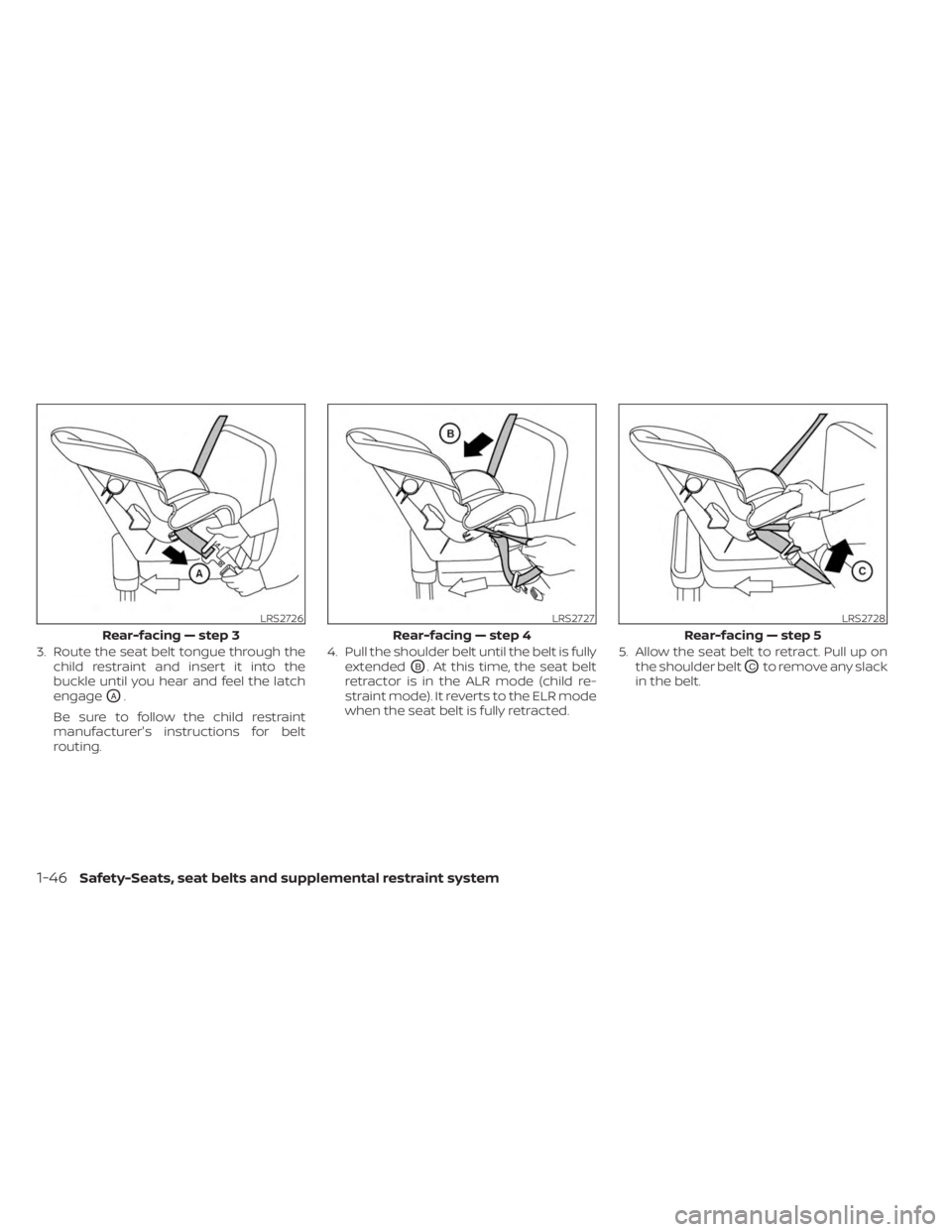
3. Route the seat belt tongue through thechild restraint and insert it into the
buckle until you hear and feel the latch
engage
OA.
Be sure to follow the child restraint
manufacturer's instructions for belt
routing. 4. Pull the shoulder belt until the belt is fully
extended
OB. At this time, the seat belt
retractor is in the ALR mode (child re-
straint mode). It reverts to the ELR mode
when the seat belt is fully retracted. 5. Allow the seat belt to retract. Pull up on
the shoulder beltOCto remove any slack
in the belt.
LRS2726
Rear-facing — step 3
LRS2727
Rear-facing — step 4
LRS2728
Rear-facing — step 5
1-46Safety-Seats, seat belts and supplemental restraint system
Page 75 of 556
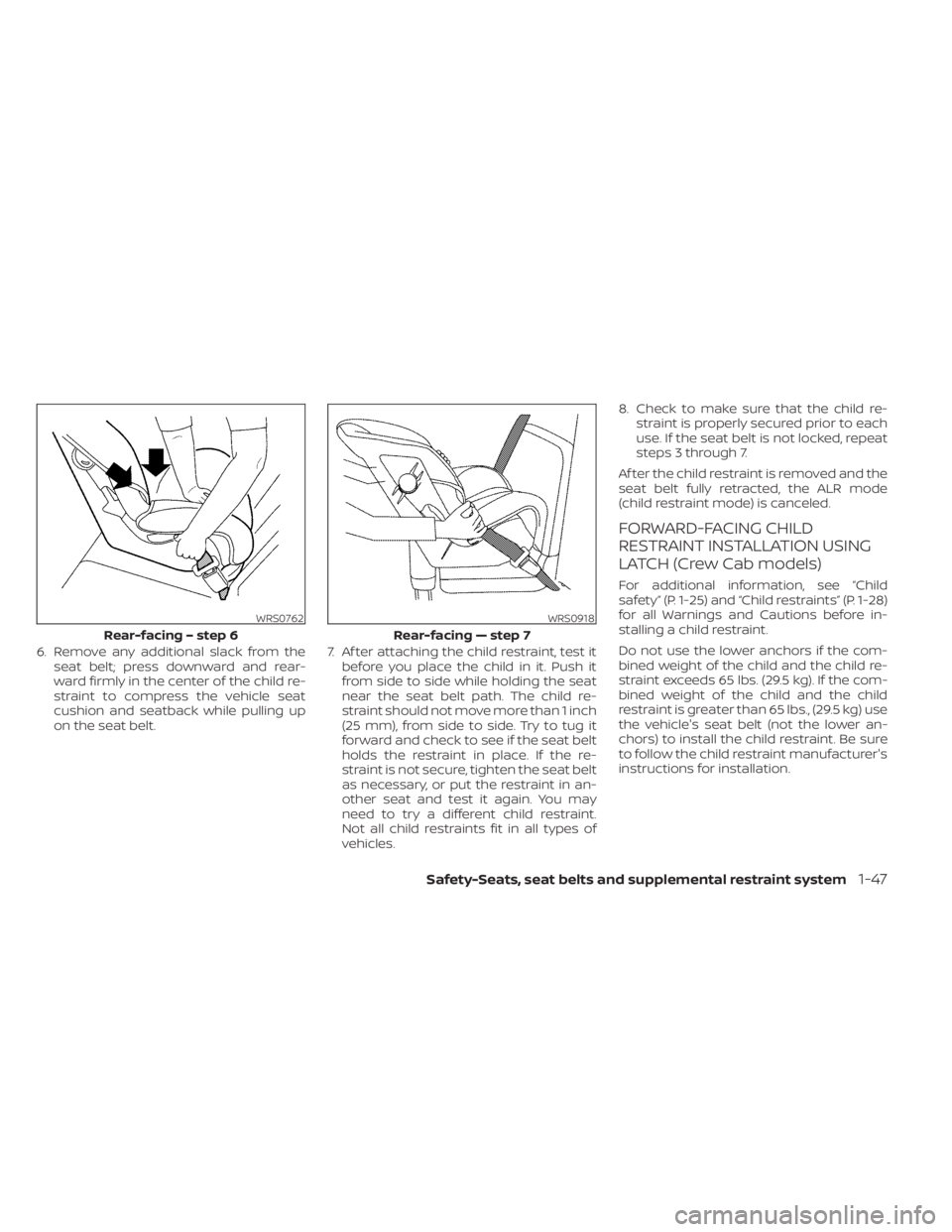
6. Remove any additional slack from theseat belt; press downward and rear-
ward firmly in the center of the child re-
straint to compress the vehicle seat
cushion and seatback while pulling up
on the seat belt. 7. Af ter attaching the child restraint, test it
before you place the child in it. Push it
from side to side while holding the seat
near the seat belt path. The child re-
straint should not move more than 1 inch
(25 mm), from side to side. Try to tug it
forward and check to see if the seat belt
holds the restraint in place. If the re-
straint is not secure, tighten the seat belt
as necessary, or put the restraint in an-
other seat and test it again. You may
need to try a different child restraint.
Not all child restraints fit in all types of
vehicles. 8. Check to make sure that the child re-
straint is properly secured prior to each
use. If the seat belt is not locked, repeat
steps 3 through 7.
Af ter the child restraint is removed and the
seat belt fully retracted, the ALR mode
(child restraint mode) is canceled.
FORWARD-FACING CHILD
RESTRAINT INSTALLATION USING
LATCH (Crew Cab models)
For additional information, see “Child
safety” (P. 1-25) and “Child restraints” (P. 1-28)
for all Warnings and Cautions before in-
stalling a child restraint.
Do not use the lower anchors if the com-
bined weight of the child and the child re-
straint exceeds 65 lbs. (29.5 kg). If the com-
bined weight of the child and the child
restraint is greater than 65 lbs., (29.5 kg) use
the vehicle's seat belt (not the lower an-
chors) to install the child restraint. Be sure
to follow the child restraint manufacturer's
instructions for installation.
WRS0762
Rear-facing – step 6
WRS0918
Rear-facing — step 7
Safety-Seats, seat belts and supplemental restraint system1-47
Page 76 of 556
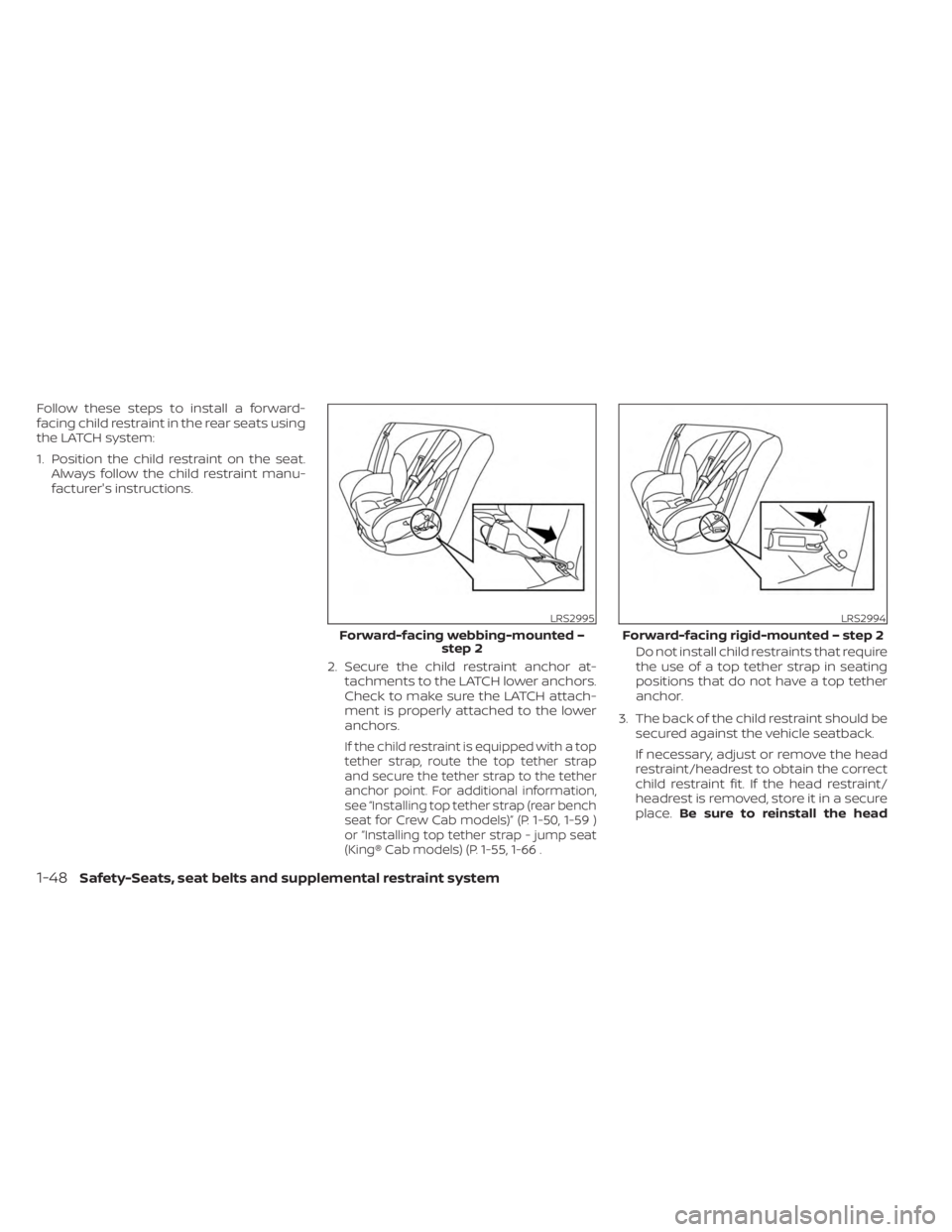
Follow these steps to install a forward-
facing child restraint in the rear seats using
the LATCH system:
1. Position the child restraint on the seat.Always follow the child restraint manu-
facturer's instructions.
2. Secure the child restraint anchor at-tachments to the LATCH lower anchors.
Check to make sure the LATCH attach-
ment is properly attached to the lower
anchors.
If the child restraint is equipped with a top
tether strap, route the top tether strap
and secure the tether strap to the tether
anchor point. For additional information,
see “Installing top tether strap (rear bench
seat for Crew Cab models)” (P. 1-50, 1-59 )
or “Installing top tether strap - jump seat
(King® Cab models) (P. 1-55, 1-66 .
Do not install child restraints that require
the use of a top tether strap in seating
positions that do not have a top tether
anchor.
3. The back of the child restraint should be secured against the vehicle seatback.
If necessary, adjust or remove the head
restraint/headrest to obtain the correct
child restraint fit. If the head restraint/
headrest is removed, store it in a secure
place. Be sure to reinstall the head
LRS2995
Forward-facing webbing-mounted –
step 2
LRS2994
Forward-facing rigid-mounted – step 2
1-48Safety-Seats, seat belts and supplemental restraint system
Page 77 of 556
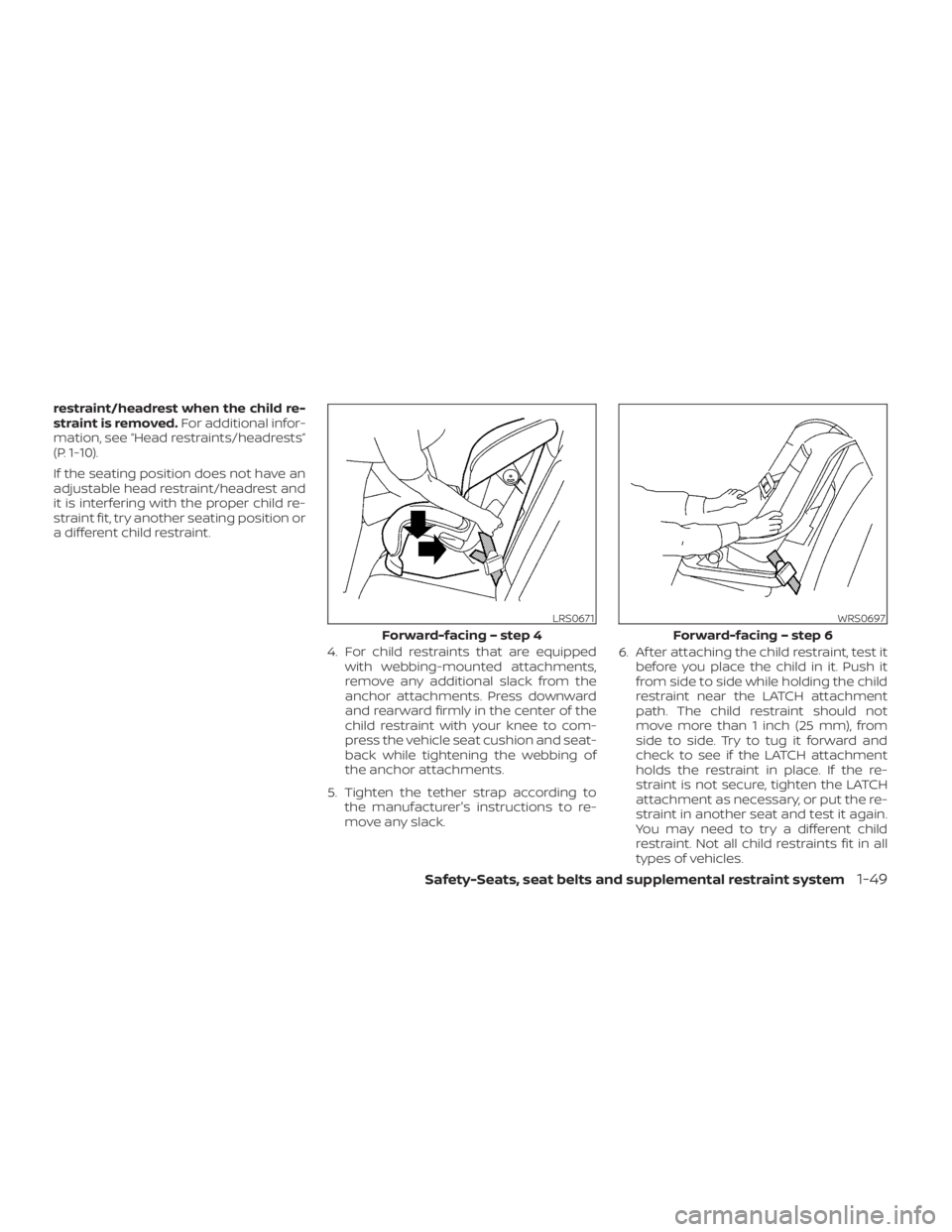
restraint/headrest when the child re-
straint is removed.For additional infor-
mation, see “Head restraints/headrests”
(P. 1-10).
If the seating position does not have an
adjustable head restraint/headrest and
it is interfering with the proper child re-
straint fit, try another seating position or
a different child restraint.
4. For child restraints that are equippedwith webbing-mounted attachments,
remove any additional slack from the
anchor attachments. Press downward
and rearward firmly in the center of the
child restraint with your knee to com-
press the vehicle seat cushion and seat-
back while tightening the webbing of
the anchor attachments.
5. Tighten the tether strap according to the manufacturer's instructions to re-
move any slack. 6. Af ter attaching the child restraint, test it
before you place the child in it. Push it
from side to side while holding the child
restraint near the LATCH attachment
path. The child restraint should not
move more than 1 inch (25 mm), from
side to side. Try to tug it forward and
check to see if the LATCH attachment
holds the restraint in place. If the re-
straint is not secure, tighten the LATCH
attachment as necessary, or put the re-
straint in another seat and test it again.
You may need to try a different child
restraint. Not all child restraints fit in all
types of vehicles.
LRS0671
Forward-facing – step 4
WRS0697
Forward-facing – step 6
Safety-Seats, seat belts and supplemental restraint system1-49
Page 78 of 556
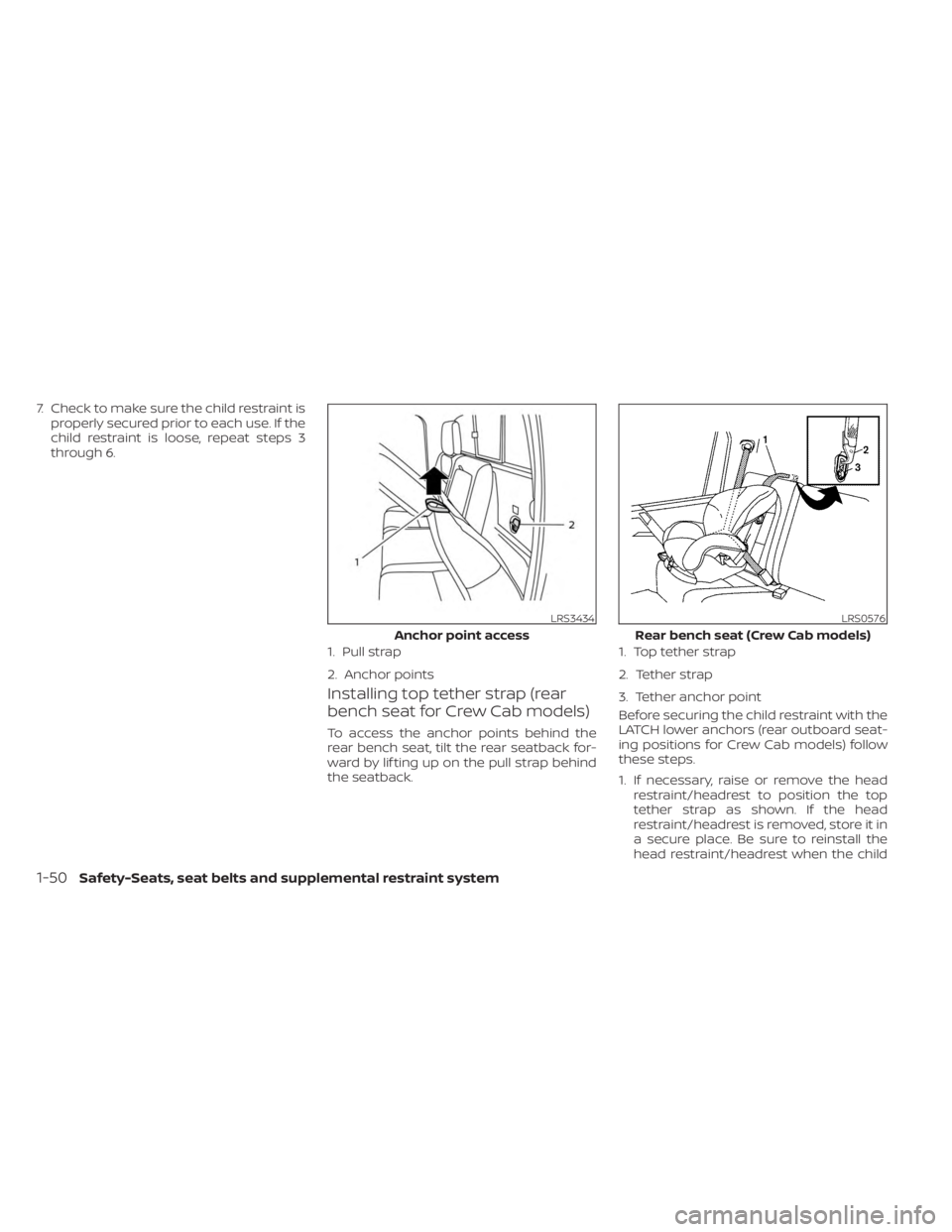
7. Check to make sure the child restraint isproperly secured prior to each use. If the
child restraint is loose, repeat steps 3
through 6.
Installing top tether strap (rear
bench seat for Crew Cab models)
To access the anchor points behind the
rear bench seat, tilt the rear seatback for-
ward by lif ting up on the pull strap behind
the seatback. Before securing the child restraint with the
LATCH lower anchors (rear outboard seat-
ing positions for Crew Cab models) follow
these steps.
1. If necessary, raise or remove the head
restraint/headrest to position the top
tether strap as shown. If the head
restraint/headrest is removed, store it in
a secure place. Be sure to reinstall the
head restraint/headrest when the child
LRS3434
Anchor point access
1. Pull strap
2. Anchor points
LRS0576
Rear bench seat (Crew Cab models)
1. Top tether strap
2. Tether strap
3. Tether anchor point
1-50Safety-Seats, seat belts and supplemental restraint system
Page 79 of 556
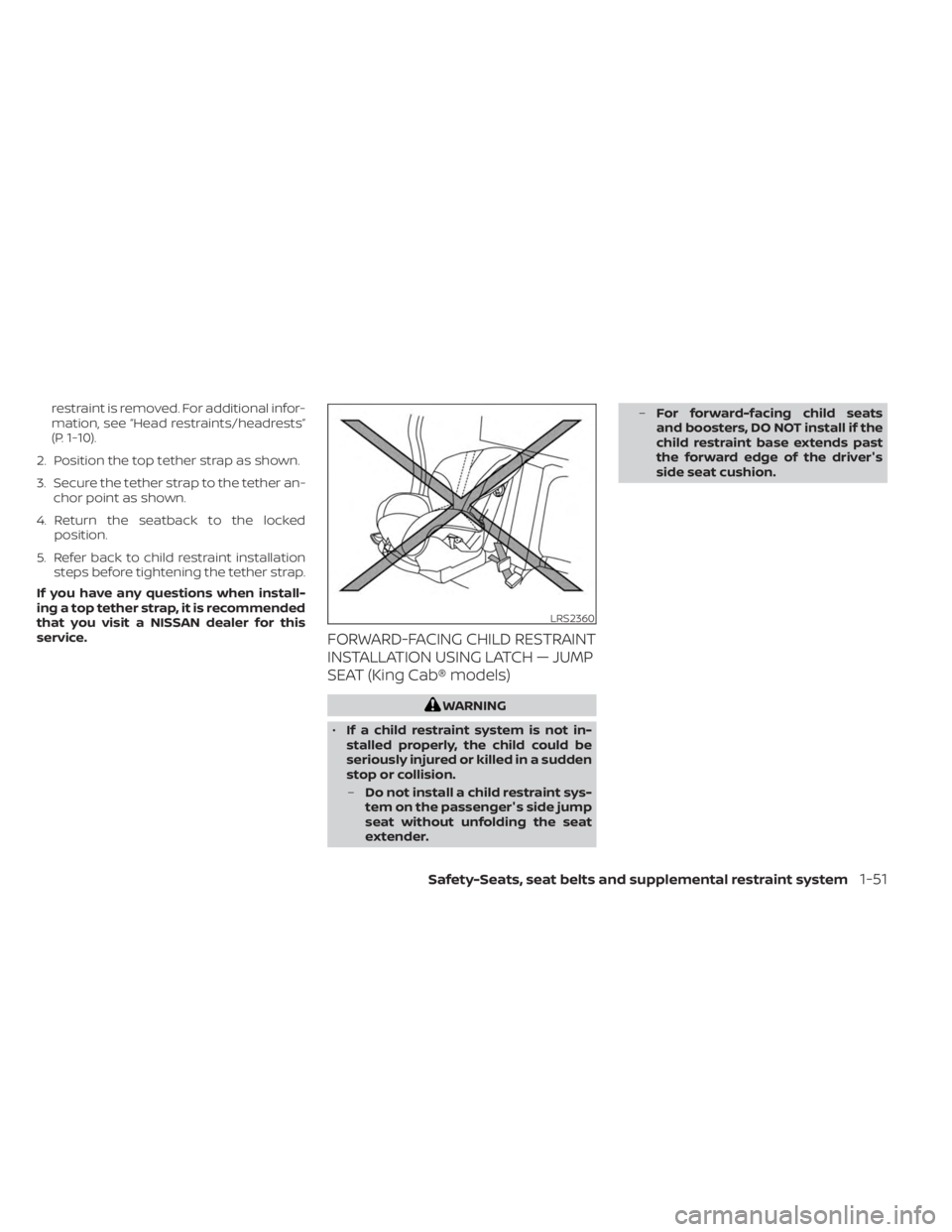
restraint is removed. For additional infor-
mation, see “Head restraints/headrests”
(P. 1-10).
2. Position the top tether strap as shown.
3. Secure the tether strap to the tether an- chor point as shown.
4. Return the seatback to the locked position.
5. Refer back to child restraint installation steps before tightening the tether strap.
If you have any questions when install-
ing a top tether strap, it is recommended
that you visit a NISSAN dealer for this
service.
FORWARD-FACING CHILD RESTRAINT
INSTALLATION USING LATCH — JUMP
SEAT (King Cab® models)
WARNING
• If a child restraint system is not in-
stalled properly, the child could be
seriously injured or killed in a sudden
stop or collision.
– Do not install a child restraint sys-
tem on the passenger's side jump
seat without unfolding the seat
extender. –
For forward-facing child seats
and boosters, DO NOT install if the
child restraint base extends past
the forward edge of the driver's
side seat cushion.
LRS2360
Safety-Seats, seat belts and supplemental restraint system1-51
Page 80 of 556
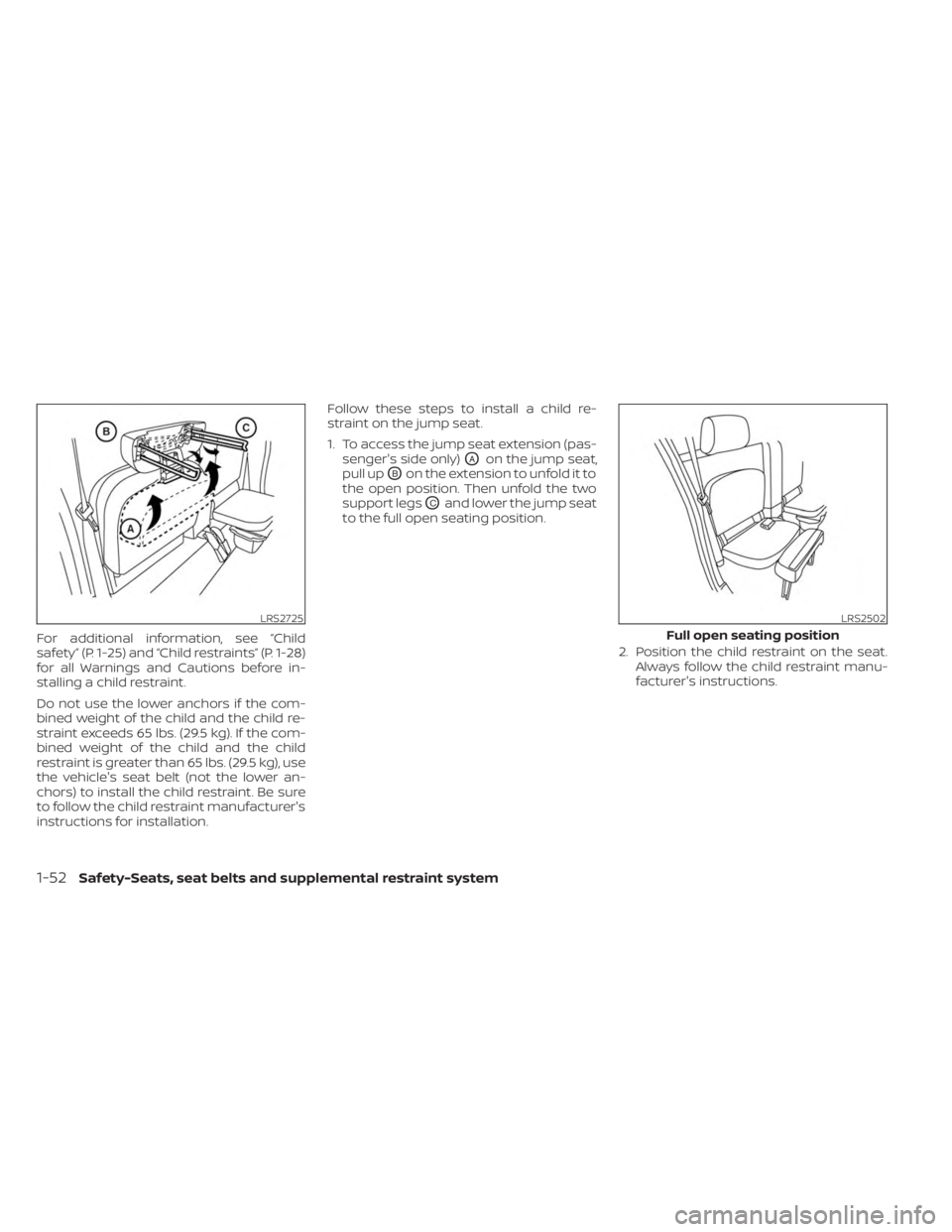
For additional information, see “Child
safety” (P. 1-25) and “Child restraints” (P. 1-28)
for all Warnings and Cautions before in-
stalling a child restraint.
Do not use the lower anchors if the com-
bined weight of the child and the child re-
straint exceeds 65 lbs. (29.5 kg). If the com-
bined weight of the child and the child
restraint is greater than 65 lbs. (29.5 kg), use
the vehicle's seat belt (not the lower an-
chors) to install the child restraint. Be sure
to follow the child restraint manufacturer's
instructions for installation.Follow these steps to install a child re-
straint on the jump seat.
1. To access the jump seat extension (pas-
senger's side only)
OAon the jump seat,
pull up
OBon the extension to unfold it to
the open position. Then unfold the two
support legs
OCand lower the jump seat
to the full open seating position.
2. Position the child restraint on the seat.Always follow the child restraint manu-
facturer's instructions.
LRS2725LRS2502
Full open seating position
1-52Safety-Seats, seat belts and supplemental restraint system